Introduction
This project starts as a continuation from MRAC 1 project to digitize the urban mining practice in a circular economy environment.
The construction industry is the number one consumer of global raw materials while being one of the biggest producers of waste in the European Union. It accounts for approximately one third of all waste generated and up to half of all the solid waste produced in the United States. In some European countries reuse and high-quality recycling (upcycling) of construction and demolition waste remains below 3%. The sector is facing a non sustainable resource consumption where poor digitalization and unstructured data is one of the key factors hindering better exploitation of circular opportunities.
In order to diminish the dependency on new natural resources reduce the overall environmental costs of the industry (extraction of raw material, its transportation and the manufacturing of new construction elements), this project employs an automatic digitization method for the near-end life cycle stage of a building and considers it as a source of high value assets. The subsequent dataset is then transferred to designers and builders to promote the use of valuable secondary-source materials and better inform early design decisions when repurposing construction waste.
The first part of the research develops an innovative digital decision support system on 3 demonstrators, integrating various digital tools and processes (3D scanning, imagery localization and point cloud classification) that helps to define the most sustainable and economical deconstruction and reuse strategy for a building.? The results showed that it is possible to quantify, qualify and map the flows of products and materials from buildings undergoing renovation, redevelopment or deconstruction and to assess, even before the work begins, their potential for reuse and recycling.
The second part of the research links the database with a computational design tool that can be integrated into construction software for architects and construction companies. The proposed system both matched the designed components with relevant stored materials by their design requirements, as well as providing suggestions for design changes. The proposed iterations aim to optimize repurposed material utilization, performance, and cost.
The research reduces the environmental impact of the sector by promoting the use of locally sourced, readily available, and reclaimed materials in an automated way. It exposes the potential for constructing big data sets of reusable materials, digitally available, for sharing and organizing material harvesting and facilitating its incorporation in new designs. Thanks to this anticipatory approach and digital classification, the materials identified (for example: windows, metal beams, doors, etc.) on deconstruction or renovation sites are directed to reuse actors , and may, in the future, be oriented towards new building construction programs, promoting the circular economy in a short loop.
Contextualization
Focus on reuse is shifting from purely materials (demolition view) to product and component reuse (with higher residual value)
Find more details about the impact of the research here.
Environmental:
-
- More than 80% of the european buildings will still be here in 50 years, increasing the need for selective demolition techniques for renovation
- Reusability percentage of CDW goals are getting higher
Social:
- Constant raise of awareness of waste as valuable assets
- General distrust in automation processes in the sector
Economic:
- New revenues from a given asset through repair and refurbishment schemes
- New business opportunities and new markets in the coming years through the circular economy environment.
- Near future increased competition. New stakeholders that can provide reuse information and reclaimed (cleaned, repaired,…) products to the buyer/ recipient of secondary products, components or material
Political:
- National Sector Opportunity: Spain ranked 9th in the 2017 Eco-Innovation Scoreboard. Strongest performance is in Resource Efficiency outcomes. It promotes a more sustainable and digitalised construction.
- Increased European concern about urban mining. Circular economy goals
- Future european demonstrators as BAMB projects can update general guidelines for material passports and include new data items. This can result in new data acquisition processes
Legal:
- Any C&D waste management plan needs to follow the guidelines established by Plan Estatal Marco de Gestión de Residuos PEMAR (2016-2022) in Spain which includes information like: Percentage of recycling and reuse of construction materials and products.
- Deconstruct companies (i.e. Urban Mining) adhering to regulatory compliance rules and legislation when planning and executing deconstruction activities.
Setting the Framework
Waste Management Framework



Research Aims
Mapping the Stakeholders
Roles and interactions during the repurpose & demolition phase in a New Value Chain. More than 10 new players. For a complete evaluation of the stakeholders click here. Opportunities to tackle with digitalization and the technology developed.

References | Marketplace
Connecting Suppliers & Buyers References | Planners
References | Planners
Consultancy. Design working with the new value chain.
References | Service platforms
Matching Materials
Material Dataset
How to create a demand to use obsolete buildings as a source of high value assets and materials, giving those resources valuable second lifes and market availability? This work aims aim to push forward contemporary material reuse practices at scale with complementary automation practices. Firstly, in the initial measuring and gathering stage of the data profiles of these elements. Secondly, aiming to run the searching platform at a wider level, and third to apply the material preparation and application considerations automatically, (such as structural analysis, cleaning, transportation, etc).
Sub stages during the repurposing & demolition phase
Types of information
This information helps to understand from which layers upcycle (plan the life cycle) and what products we can produce. Longevity. For example it could be dangerous to use buildings structure assemblies to make furniture which it’s lifespan is only 5 or 10 years.
Reference | Pre-demolition analysis 
Case Study Development
Implementation steps
Workflow
Building Inspection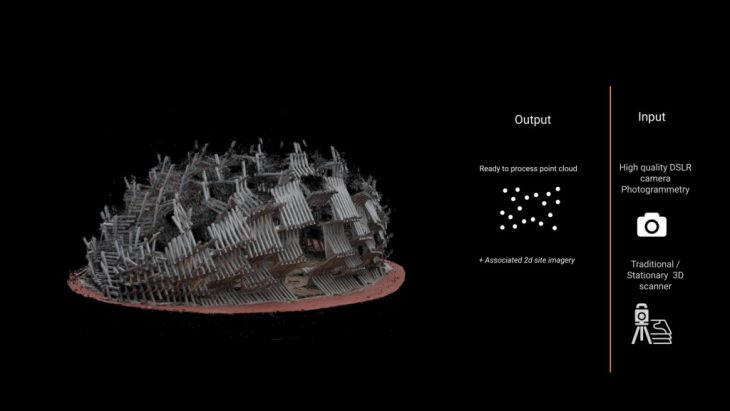

Geometric Reconstruction



Classification and Localization
Localizing within point clouds
Model Material Association

User Interface

Please refer to the element scale here
Design Strategy
Building material factors, such as economics of resource scarcity, embodied energy in material production, and low recyclability values necessitate a new approach to building design that considers the potential lifespan and value of materials beyond their function in a single ‘permanent’ spatial configuration.
How to design timber structures based on limited, secondary and non-standard resources [reclaimed], through a material database and robotic feedback; creating evolved circular architecture aesthetic?
Area of Focus
Sub stages during the design phase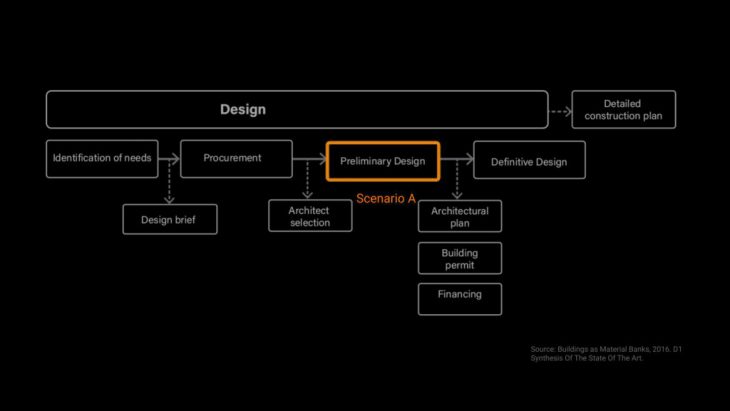
Positioning
The design team getting information/ samples/ demos of reused/ refurbished building products planned to can be used in the building, and understand product properties like specifications, dimensions, status, materials, etc. What is important here is a transparent, reliable and easy visibility on the available supply of repurposed building modules and/or materials, as well as their specifications that are important for selection. That could include additional certifications such as C2C.
References | Non standard materials
Academy

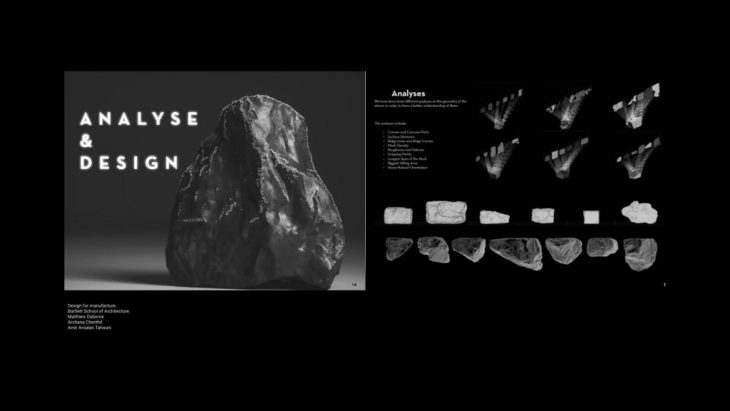
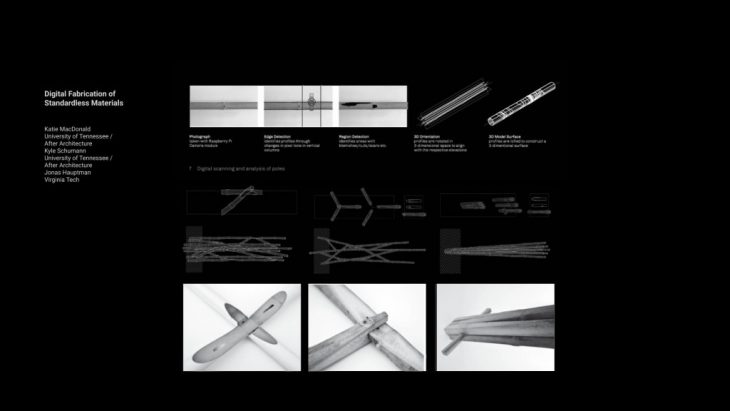
Demonstrator Index
Proposed Workflow
Feedback from irregular and scarsed elements
Surface manipulation
Identifying Imperfections (within threshold of mesh curvature)
Imperfection as design opportunities
Wave function collapse for aggregation strategy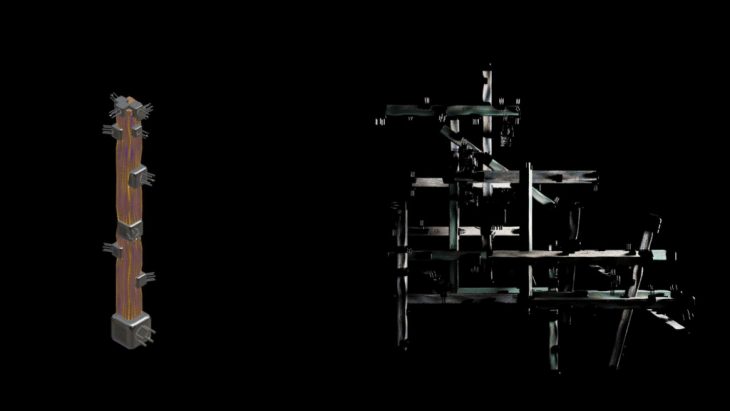
Preliminary results
Commercialization
Refer to the commercialization section here





Further Steps
- Integrate different scales in the user interface for a better diagnosis of resources
- Building scale scan at least with photogrammetry (sending instructions)
- Organize selective demolition / dismantling
- Marketplace connectivity
Current Pilot

Matter Site is a project of IaaC, Institute for Advanced Architecture of Catalonia developed at the MRAC-02 program in 2020/21 by:
Students: Matt Gordon and Roberto Vargas
Tutors: Alexandre Dubor and Aldo Sollazzo




